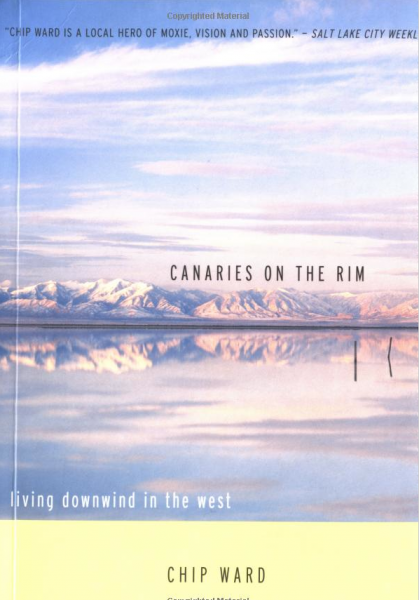Canaries on the Rim by Chip Ward is a small book that tells a big story. More accurately, it tells several big stories. One of them is about the evolution of Ward and his wife from 1973 when “…we still regarded ourselves as hippies, two kids just-married, childless and eager to explore. We had vagabonded around Europe the year before and the West was next.”…to 1999 by which time Ward and his wife have two children, live in Grantsville, Utah next to the largest stockpile of nerve gas on earth, from where Ward manages Utah’s public library program and has become one of the most respected and effective environmental activists in America. Ward is a co-founder of West Desert HEAL, Families Against Incinerator Risk and Citizens Against Chlorine Contamination. He tells the tale of his transformation from vagabond hippie to responsible family man, good neighbor, citizen and eco-warrior activist with humor, humility and hard facts. Chip Ward is a gem, as is his book.
During his journey he learns several fundamental lessons about man’s relationship with and impact on the earth, none more significant than this: “…for the first time in our lives the connections between our bodies and the water and the soil that nourished us appeared short and simple.” An easterner who first moves to the desert and sandstone canyons of southern Utah, Ward learns about the degradation of that desert and those canyons’ environment by the cattle industry. He tells the story of one cow loose in one canyon as example and metaphor for how the cattle industry in less than 100 years turned a valley with grasses as high as a man’s head into what he describes as a “dust bowel.”
The Wards move to Grantsville, on the rim of the Great Basin, in order to raise their family in a small town with small town values. They discover that a great deal of the Great Basin had been turned into a “military sacrifice zone” by an abusive U.S. military, governmental complacency and betrayal, and the on-going “war between economy and ecology.” Ward discovers that small town values are more complicated than they appear, that small populations in places like the Great Basin are often desperate for economic advantage, that desperate people value health and the environment less than jobs and revenue.
Aging bombs from the nearby Tooele Army Depot were regularly exploded in pits near town before they become unstable, shaking homes and frightening animals, children, and anyone who thought about the long-term effects on the water and air and soil and living beings from the chemicals released by thousands of explosions of the tools of war.
Ward discovers that Grantsville is next door to the Magcorp magnesium refinery which by itself provides Utah with 90 percent of its toxic pollution. He realizes that Magcorp workers park their new cars 20 miles from work and ride to the plant in a bus. This is done not to save gas by carpooling, but, rather, because the fumes from the refinery tend to eat the new paint off those new cars. Fortunately, human lungs are not coated with paint.
In the early 1990’s Ward becomes engaged in a grass roots movement to block the building of the toxic waste incinerators at the Tooele Army Depot, known as Chemical Agent Munitions Disposal System (CAMDS). The purpose CAMDS is to incinerate nerve gas, but Ward and many others, including several ‘whistle blowers’ who worked at the facility, believe it releases deadly toxins into the environment rather than destroying them. He meets people he describes as the “walking wounded of the military’s war on the environment” who are victims of stillbirths, miscarriages, birth defects, blood disorders, cancer and chronic ailments that defy diagnosis. He writes of these walking wounded who have turned into activists, “One look at them and it was clear that environmental issues are about who has power and how that power is employed. They don’t build chemical weapons incinerators in Aspen. I met no activists named Winfield or Muffy.”
He studies the history of nuclear bomb testing in Nevada in the 1950s. He learns that the ‘downwinders,” largely the Mormon population of Utah who have a tradition of patriotism and obedience to authority and who happened to live downwind from the bomb testing in the Great Basin, and the soldiers who took part in those tests, were sacrificed by the American government.
A turning point in Ward’s life as an environmental activist was a meeting in the office of Utah’s U.S. Senator Jake Garn during which Garn and a retired U.S. Navy admiral exhibited a colossal ignorance of world history, international relationships and rational thought. He writes, “I could no longer rationalize my failure to speak up and act with the notion that smart people are in charge. A cantankerous future loomed.”
Ward concludes that we are all downwinders, in fact, “we are fluid creatures in a fluid world.” We are all canaries, in Ward’s view, those tiny birds in cages miners took into the mines. When the canaries died from the toxic fumes in the mines, the miners knew it was time to return to the surface. Ward lives and works on the rim of the Great Basin, and he tells a great story in Canaries on the Rim . It is a book well worth reading, containing some warnings well worth heeding.

